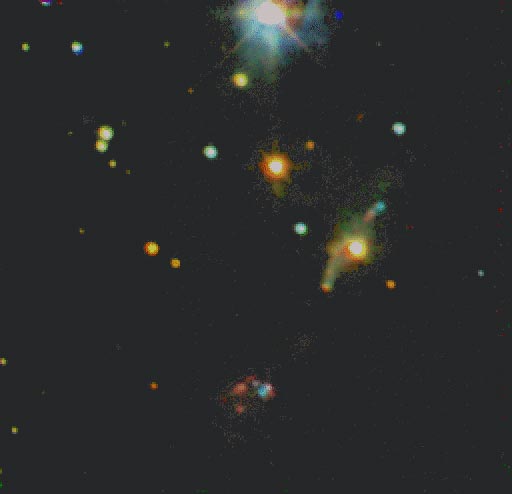

This is the near infrared image.
You may also see images at other wavelengths by clicking on the colorbar at a point above any of the dashed arrows (which point to other regions of the spectrum at which images are available). The solid arrow shows the spectral region you are seeing now. This is not intended to be a linear scale in wavelength, but only a rough guide to the wavelength of the observation.
This group of stars is a small star forming aggregate lying just south of the L1641N group. V380 Ori, the optically brightest object in this group has been recognized for a long time as a member of the Herbig Ae/Be star population (Herbig 1960); it is a young intermediate mass star. This star is the bright object illuminating the large reflection nebula (NGC 1999). The original H-H objects (Herbig 1951, Haro 1952) are also found in this field. They are the nebulous objects lying in the lower half of this field. An optical-infrared study of this region (Strom et al. 1985) was able to identify the powering source of the outflow, of which HH 1 & 2 are the visible manifestations, as the cm wavelength VLA source discovered by Pravdo et al. (1985). A water maser source, detected both by the VLA and IRAS also lies within this field as do numerous other extremely young objects as shown by the luminosity function derived for the region by Strom, Strom and Merrill in their infrared imaging study of L1641.
This near infrared pseudocolor image was made by combining the images at J (blue), H (green) and K (red). The shortest wavelength image is mapped into blue and the longest into red, producing the image that you see. Because these stars are so young, they are still closely associated with the dense material from which they formed. For this reason, they are much more easily seen in the infrared than in the visible region. Because the interstellar dust absorbs more effectively at shorter wavelengths, the more heavily embedded stars are seen only in the infrared. The stars that are "still forming", known as protostars, are seen only at very long wavelengths.
If you wish more information about these images, a page is available for your perusal. You may also return to the overview page.
References
Haro, G. 1952, ApJ, 115, 572
Herbig, G. 1951, ApJ, 113, 697
Herbig, G. 1960, ApJ Suppl, 4, 337
Pravdo, S.H. et al. 1985, ApJ Letters, 293, L35
Strom, K.M. et al. 1985, AJ, 90, 2281
Strom, K.M., Strom, S.E. & Merrill, K.M. 1993, ApJ, 412, 233
www@hanksville.org
© 2000